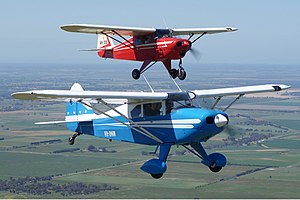Piper Tri-Pacer
| PA-20 Pacer & PA-22 Tri-Pacer Family |
|
|---|---|
 |
|
| Piper PA-22-150 Tri-Pacers. The red one is in original configuration, while the blue one has been converted to conventional landing gear | |
| Role | Civil utility aircraft |
| Manufacturer | Piper Aircraft |
| First flight | 1949 (PA-20) 1950 (PA-22) |
| Produced | 1950-1954 (PA-20) 1950-1964 (PA-22) |
| Number built | 1120 (PA-20) 9490 (PA-22) |
| Variants | Javelin V6 STOL |
The PA-20 Pacer and PA-22 Tri-Pacer are a family of four-place, strut braced, high-wing light aircraft that were built by Piper Aircraft in the post-World War II period.
The Pacer was essentially a four-place version of the two-place PA-17 Vagabond light aircraft. It features a steel tube fuselage and an aluminum frame wing, covered with fabric, much like Piper's most famous aircraft, the Cub and Super Cub. An aircraft prized for its ruggedness, spacious cabin, and, for its time, impressive speed, many Pacers continue to fly today.
Factory installed 125 hp (93 kW), 135 hp (100 kW), 150 hp (112 kW), and 160 hp (120 kW) engine options were available, and 180 hp (135 kW) engine after-market conversions are an option.
The Piper PA-20 Pacer was originally designed as a tailwheel aircraft and thus had somewhat limited forward visibility on the ground and more demanding ground-handling characteristics. To help introduce more pilots to easier, safer flying, from February 1951, Piper introduced the PA-22 Tri-Pacer with a nosewheel instead of the tailwheel landing gear. Both the Pacer and the Tri-Pacer belong to a sub-group of Piper aircraft called "Short Wing Pipers." Additionally, the Tri-Pacer offered higher-powered engine options in the form of 150 hp (112 kW) and 160 HP (120 kW) engines, whereas the largest engine available to the original Pacer had an output of 135 hp (100 kW). At the time the tricycle undercarriage became a popular preference and 1953 saw the PA-22 Tri-Pacer outsell the Pacer by a ratio of six to one. Due to the geometry of the nosewheel installation it is sometimes called the "Flying Milk Stool".
In 1959 and 1960 Piper offered a cheaper, less well-equipped version of the Tri-Pacer with a 150 HP (112 kW) Lycoming O-320 designated the PA-22-150 Caribbean. Over 8000 Tri-Pacers were produced between 1953 and 1960 when production ended, with over 2000 still registered with the FAA in 2006.
An unusual feature of the Tri-Pacer is the incorporation of bungee-linked ailerons and rudder. Beside simplifying the coordination of inflight manoeuvres, this system which can easily be overcome by the pilot as required, allowed the installation of a simplified form of autopilot marketed by Piper under the name Auto-control.
...
Wikipedia
